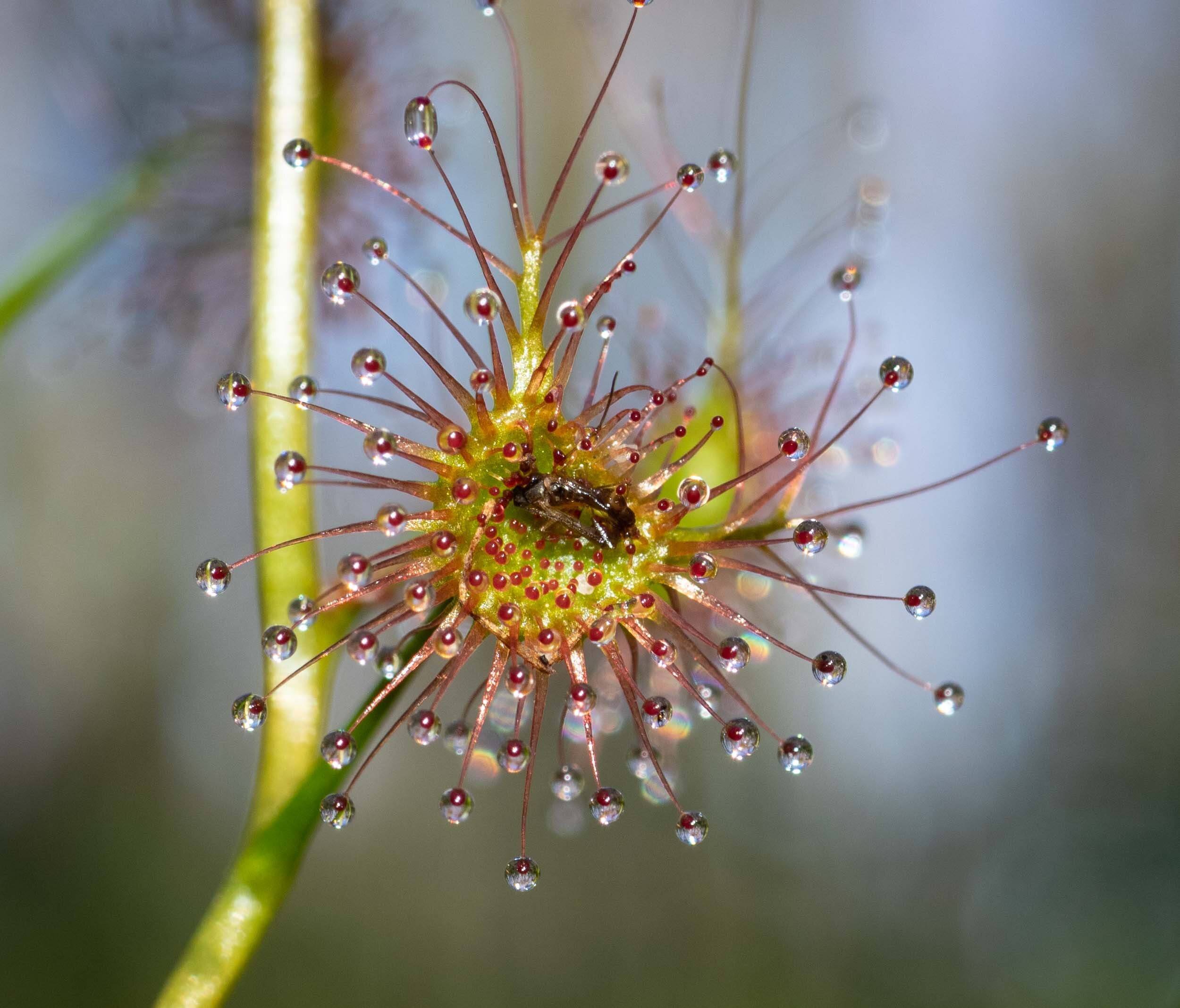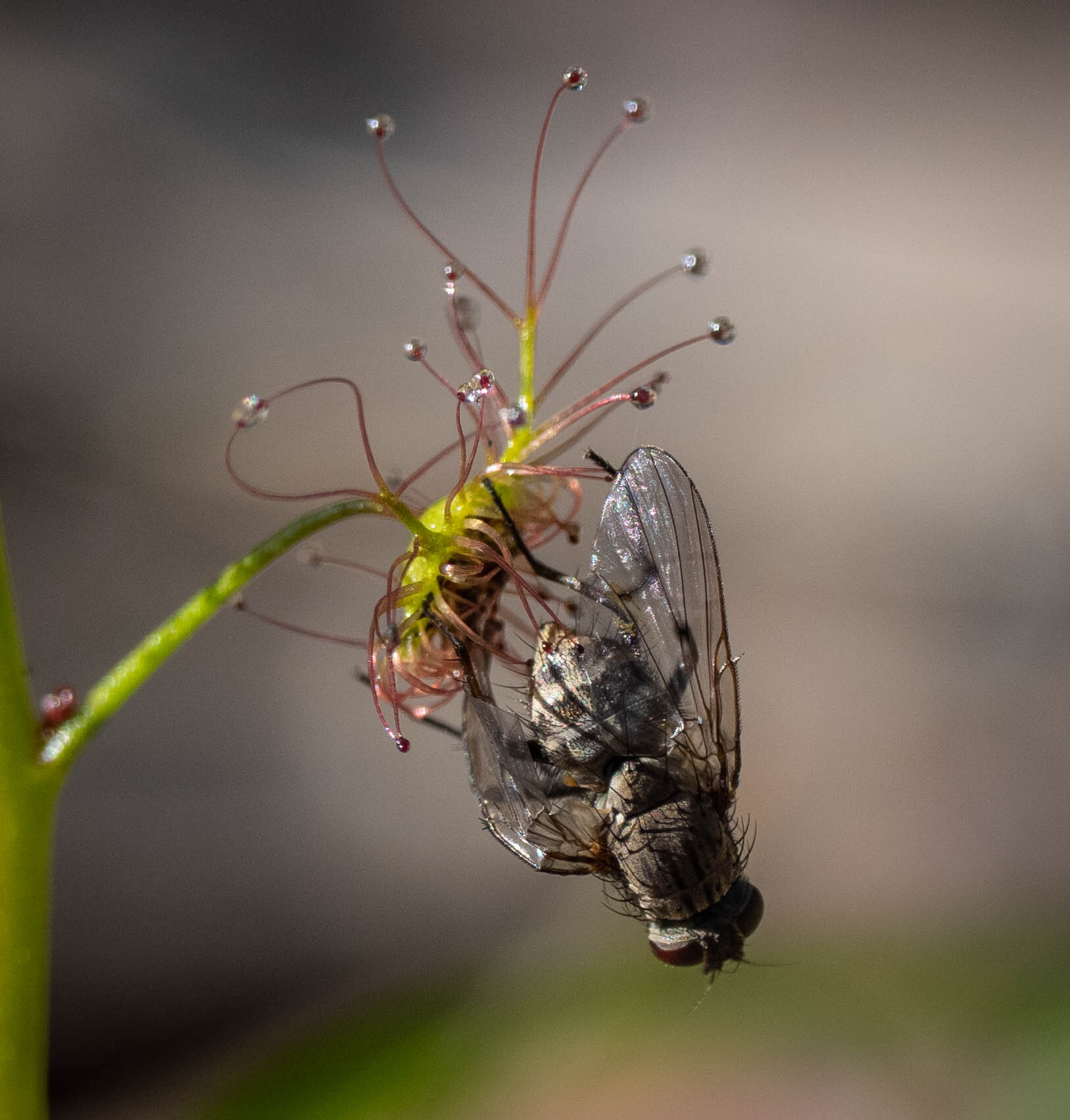Rainbow Sundews

Sundews are familiar to many people. Along with pitcher plants and the famous Venus Flytrap, sundews are among the carnivores of the plant world. These plants have long captured people’s imagination. They seem to cross the line that neatly divides plants from animals. Some are bizarre, some are grotesque, but others are quite beautiful.
To my mind our local sundews are truly beautiful. Drosera auriculata have reappeared in huge numbers since the fire. They are small and easily overlooked in the shade – but in the sun their sparking leaves are eye catching!
Drosera auriculata – the tops of two adjacent plants, each with a cluster of unopened flower buds
Drosera are found in many countries, but the centre of diversity is here. There are around 200 species globally, and about half of those are Australian. They are found in a wide range of habitats – permanent wetlands to seasonally-dry scrub, bright sunshine to full shade. The common theme is their ability to thrive in nutrient-poor soils. Sundews have a competitive edge over their neighbours, obtaining nitrogen and phosphate from the insects they consume.
Of course sundews do still photosynthesise. They use the energy from sunlight to fix carbon, forming sugars and complex carbohydrates. They are true plants … just with a taste for meat.
Our local species
Drosera auriculata is the only sundew we’ve found growing here. It is a member of a Drosera sub-genus (Ergaleium) commonly called Rainbow Sundews (ref.1)
The plants appear in Autumn and flower from late Winter. By Summer they are gone.
The early leaves form a rosette on the ground but all later leaves arise from a single, erect stem.
The leaves are supported by long, stiff petioles (leaf stems) and so each is held at a distance from its neighbours.
The back of the leaf is smooth, green and photosynthetically active (I presume). But the front is where the real action takes place!
Sundew flowering has begun in earnest this week, so I’ve taken to crawling about with my camera for a closer look at the plants. Insect numbers are low – Winter is still with us – so I’ve been surprised by the success of the little carnivores. It seems that every plant is holding several insects, in various stages of decomposition!
I’ve also been reading up a bit, trying to make sense of what I’m seeing.
There is a lot of research on Drosera. The plants have a long history of medicinal use and there is continued interest in their chemical properties. Sundews also attract attention from ecologists, plant physiologists and evolutionary biologists. Yet despite this wealth of information, I confess I’m still not sure I understand exactly how our local plants function. For a start, most of the studies have involved species other than D. auriculata. Also, research findings differ depending upon the conditions of the experiment. With that caveat in mind, here’s what I’ve observed and learned so far…
The trap
Each leaf is a trap. Around the edge are long, stalked glands – ‘tentacles’. The tentacles become progressively shorter away from the leaf edge. The most central glands are simple red bumps, without stalks. The tentacles are primarily involved in prey capture, while the central region is involved in digestion and absorption.
Tentacles move!
The head of each tentacle secretes a large drop of glue, forming a shining globe. On contact, the insect is stuck fast and the trap is triggered. The initial contact triggers non-directional movement of the tentacles (ref.2). Chemical cues subsequently lead to directional movement and the tentacles curve inward, bringing the prey into contact with more and more sticky tentacles.
Ultimately, the trapped insect is brought into contact with the sessile glands at the centre of the leaf. Death may take a while, the result of exhaustion, suffocation or the action of digestive enzymes.
The tentacles can discriminate between prey and general debris (ref.3). I noticed small pieces of charcoal stuck to the ends of many outstretched tentacles. Reminders of the fire will be with us for a long time yet.
Fragments of burnt vegetation caught by the tentacles, which remain unflexed.
Very sticky glue
The glue has very special properties. It is a strong adhesive and highly elastic. And it has excited the interest of medical research. In addition to polysaccharides, salts and water, the glue contains various nanoparticles. Biotechnology researchers speculate that nanoparticles may play a role in insect capture – perhaps by increasing the surface contact and force, perhaps by lending the glue its high elasticity (ref.4). Dried, this glue has potential medical application in tissue engineering, encouraging both the attachment and growth of living cells.
Microbes aid digestion
Many of the enzymes that sundews need in order to break down insect prey come from bacteria and fungi (ref.5). These microbes are of particular importance in breaking through the insect exoskeleton, as only they can digest chitin. The central leaf glands then absorb the breakdown products, securing nutrients to support the plant’s photosynthesis and growth (ref.6).
By this stage, the prey species is usually quite unrecognisable.
Pollinator or prey?
Like many Australian sundews, D. auriculata produces tubers. Plants retreat during the dry conditions of Summer and reemerge in Autumn (ref.1). In addition, tubers enable one plant to become many – a form of vegetative, asexual reproduction.
Sundews also reproduce sexually. Our plants are currently flowering and to effectively cross-pollinate they need insects to move from one flower to the next. Safely.
Given that the flowers are close to such deadly leaves, how do the sundews avoid killing off all their potential pollinators?
In seeking an answer to this question I struck ‘Google Scholar gold’! A research publication specifically investigating how D. auriculata (and two other Drosera species) deal with the ‘pollinator-prey conflict’ (ref.7).
It turns out that our little sundews are really quite unusual among Drosera. D. auriculata has scented flowers and scented leaves, and the two odours are distinct. Pollinating insects from the fly families Syrphidae (hoverflies), Muscidae (houseflies) and Tachinidae (tachinid flies) find the flower scent attractive. It smells like flowery honey, according to chemical analysis. But more importantly, these same flies don’t like the leaf smell. They avoid it.
In contrast, several types of ‘lower Diptera’ (fungus gnats, mosquitoes), plus various Hymenoptera (wasps and ants) and small Hemiptera (bugs) are strongly attracted by the scent of the leaves. This explains my observations – lots of trapped mozzies, midges, wasps and ants.
Yet escape is possible, and perhaps it helps to be large and strong. I watched this fly struggling against the sticky tentacles for nearly 15 minutes, before it ultimately fought its way clear.
A quick bit of grooming and it flew off, apparently unharmed.
References
Gibson, R., Conn, B.J. & Bruhl, J.J. 2012. Morphological evaluation of the Drosera peltata complex (Droseraceae). Australian Systematic Botany, 25, 49-80 (available)
Lüttge U. (1983) Ecophysiology of Carnivorous Plants. In: Lange O.L., Nobel P.S., Osmond C.B., Ziegler H. (eds) Physiological Plant Ecology III. Encyclopedia of Plant Physiology (New Series), vol 12 / C. Springer, Berlin, Heidelberg. https://doi.org/10.1007/978-3-642-68153-0_13
Nakamura, Y., Reichelt, M., Mayer, V.E. & Mithöfer, A. 2013. Jasmonates trigger prey-induced formation of ‘outer stomach’ in carnivorous sundew plants. Proceedings of the Royal Society B (Biological Sciences) https://doi.org/10.1098/rspb.2013.0228
Zhang, M., Lenaghan, S.C., Xia, L., Dong, L., He, W., Henson, W.R. & Fan, X. 2010. Nanofibers and nanoparticles from the insect-capturing adhesive of the Sundew (Drosera) for cell attachment. Journal of Nanobiotechnology, 8: 20 https://doi.org/10.1186/1477-3155-8-20
Chandler, G.E. & Anderson, J.W. 1976. Studies on the origin of some hydrolytic enzymes associated with the leaves and tentacles of Drosera species and their role in heterotrophic nutrition. New Phytologist. 77, 51-62.
Chandler, G.E. & Anderson, J.W. 1976. Studies on the nutrition and growth of Drosera species with reference to the carnivorous habit. New Phytologist. 76, 129-141.
El-Sayed, A., Byers, J. & Suckling, D. 2016. Pollinator-prey conflicts in carnivorous plants: When flower and trap properties mean life or death. Sci Rep 6, 21065 (2016). https://doi.org/10.1038/srep21065
Note: Drosera auriculata is similar to D. peltata, but may be distinguished by a close look at the floral sepals (see ref 1 and Vicflora notes page).




































